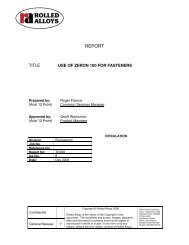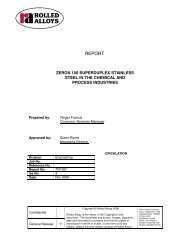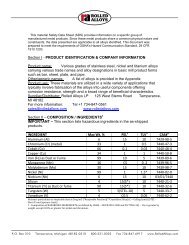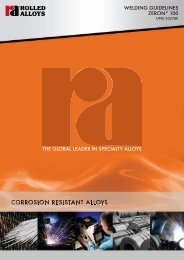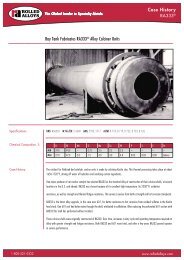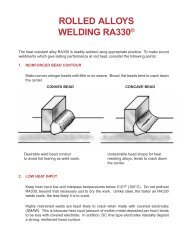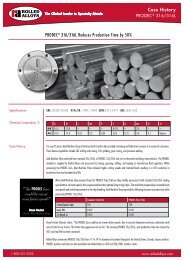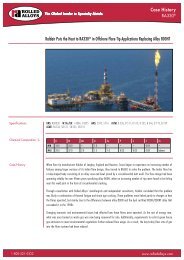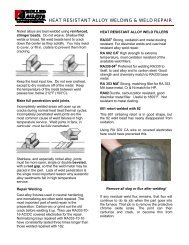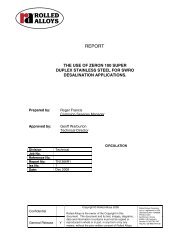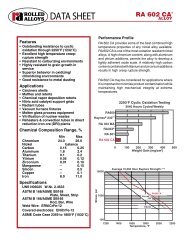AL-6XN Alloy Fabrication Manual [Corrosion ... - Rolled Alloys
AL-6XN Alloy Fabrication Manual [Corrosion ... - Rolled Alloys
AL-6XN Alloy Fabrication Manual [Corrosion ... - Rolled Alloys
Create successful ePaper yourself
Turn your PDF publications into a flip-book with our unique Google optimized e-Paper software.
TUBE BENDING AND ROLLING<strong>AL</strong>-<strong>6XN</strong> alloy tubes can be bent to a minimum bend radius of 1-1/2 times the tube outside diameter(O.D.). This is an inside radius of 1 times O.D., and a centerline-to-centerline leg spacing of3 times O.D.Unlike copper alloy or titanium tubes, <strong>AL</strong>-<strong>6XN</strong> alloy tubes may be rolled to the full thickness of thetubesheet. No provision need be made for staying back from the inside face of the tubesheet.<strong>AL</strong>-<strong>6XN</strong> alloy tubes may be successfully expanded using 3, 4 or 5-roller expanders. Selection ofthe number of rolls is largely a matter of personal preference. However, 5-roller expanders tendto be more forgiving when operator skills vary.HEAT TREATMENTIf necessary, <strong>AL</strong>-<strong>6XN</strong> alloy is annealed after heavy cold work 2050-2150°F (1121-1177C), waterquench. Slow cooling is not recommended, as this would reduce the alloy’s corrosion resistance.DESC<strong>AL</strong>ING AND PICKLINGHeavy annealing or hot working scale may be removed by abrasive blasting followed by picklingin 4% nitric, 4% hydrofluoric acid solution for about 30 minutes at 120-140°F. Water containingless than 50 ppm chlorides is preferred for this solution.Weld scale may be removed by stainless wire brushing, but this alone will leave the weldmentwith less than optimum corrosion resistance. Preferred treatment is blasting with 75-100 micronsoda-lime glass beads. Alternately, wire brushed welds may be cleaned with a commercial nitrichydrofluoricpickling paste.WELDING--FILLER MET<strong>AL</strong>S, HEAT INPUTAl-<strong>6XN</strong> alloy must be welded with overalloyed filler metal in order for the joint to have corrosionresistance equivalent to the base metal. A nominal 9% molybdenum weld filler, such asERNiCrMo-3 wire (alloy 625) or an ENiCrMo-3 electrode, is preferred. It is important that the rootbe gapped sufficiently that the weld bead is composed mostly of 9% molybdenum filler, withoutexcessive dilution by <strong>AL</strong>-<strong>6XN</strong> base metal.Heat input should be low to avoid hot cracking in the 625 weld bead. Preferably, stay below 40kilojoule per inch and definitely below 50 kJ/in.Heat input in kJ/inch is calculated:Voltage x Amperage x 6Travel Speed (inch/minute) x 1004
Interpass temperatures should be kept below 300°F (150C). On highly restrained joints or heavy(over 1/2") plate, stay below 200°F (93C). Low interpass temperature reduces chances of nickelalloy weld bead solidification cracking.The nickel alloy weld fillers used with <strong>AL</strong>-<strong>6XN</strong> give a more viscous weld pool than conventional stainlessfillers. There is a temptation to raise welding current to improve fluidity, but this increases risk ofhot cracking.COVERED ELECTRODES (SMAW)Use stringer beads with ENiCrMo-3 covered electrodes in the flat position. A slight weave, not exceedingtwo times the diameter of the electrode, may be used. Weaving is unavoidable in verticalwelds.Maintain as short an arc length as possible. A “long arc” or increased gap between electrode andworkpiece may result in weld porosity and excessive oxides in the weld. Avoid welding in the presenceof direct drafts of air, wind or fans.Remove all slag from each filler pass by use of chipping tools, fine grinding or stainless wire brushes.DO NOT USE CARBON STEEL WIRE BRUSHES. Steel particles will contaminate the weldment andlikely initiate pits in chloride environments.RA112 (ENiCrMo-3) covered electrodes must be kept dry to avoid porosity and undesirable arccharacteristics. Store these electrodes in an electric oven at 225°F (107C). Electrodes which haveabsorbed excess moisture may be reclaimed by first heating two hours at 225°F (107C), followed byone hour at 600°F (316C).Typical SMAW ParameterElectrode Direct Current Reverse Polarity, Voltagedia., inch amperes3/32 40-70 241/8 60-95 255/32 90-135 265
GAS MET<strong>AL</strong> ARC WELDING (GMAW)Shielding gas is normally 100% welding grade argon having a nominal purity of 99.996% and adew point of -77°F. Helium may be added if desired to flatten the bead contour. Argon - 25%helium is often used with pulsed arc or short-circuiting arc welding. Do not add any oxygen,carbon dioxide or nitrogen.Typical GMAW ParametersSpray-arc transfer, 100% argon shielding at 35-55 cfhWire dia., Direct Current Reverse Polarity, Voltageinchamperes0.035 180-220 28-340.045 200-260 28-34Use the high end of range for heavy plate, 3/4" and over, which can act as a heat sink.Pulsed-arc transfer, 75% argon 25% helium shielding gas, 120 pulse/secWire dia., Direct Current, Reverse Polarity, Voltageinch amperes.045 150-165 20-21SUBMERGED ARC WELDING (SAW)When sub-arc welding <strong>AL</strong>-<strong>6XN</strong> alloy, use a highly basic flux, non-chromium compensating, suchas Avesta ® Flux 805 or Böhler Thyssen's RECORD NiCrW. Do not use acid fluxes meant for 18-8stainless. Average flux consumption about one pound per pound of wire. Flux must be dry. Flux805 which has absorbed moisture may be restored by heating two hours minimum 660°F (350C).Mix the flux once during the heatingperiod to ensure uniform drying.Typical SAW ParametersWire size, DCRP Current Voltage Wire Travel SpeedInch amperes Stickout,inch inch/minute. 045 150-225 25-28 1/2 8-12.062 225-300 25-28 3/4 8-12.094 275-350 25-28 1 8-126
FLUX CORED ARC WELDING (FCAW)ENiCrMo3T-1 gas shielded welding wire is used with 75% argon-25% CO 2(C25) shielding gas. Wirefeed rolls should be knurled. Use stringer beads with very little weave, to avoid trapping slag atbead edges.Suggested Welding ParametersWire dia., Wire Feed Amperes, DCRP Volts Wire Stick-out,inch inch/min inch.045 275-350 150-210 26-31 3/8-1/2GAS TUNGSTEN ARC WELDING (GTAW)With GTAW, use straight stringer beads. Limit dilution of the weld bead by <strong>AL</strong>-<strong>6XN</strong> base metal,particularly in the root pass.2% thoriated tungsten electrodes (AWS EWTh-2) are used, with direct current straight polarity(electrode negative). For good arc control, grind the electrode tip to a 30 to 60 degree point, witha small flat at the tip. Grind lines should be parallel to the electrode, not circumferential. Finishgrind on a 120 grit wheel. Adjust the arc on clean scrap metal, with no scale. Use 1/2 inch minimum(No. 8) gas cup with gas lens. Shielding and purge gases normally 100% argon for manual welding.*Typical GTAW Parameters2% Thoriated Direct CurrentTungsten Electrode dia., inch Straight Polarity (electrode negative), amps Voltage.040 25-80 10-14.062 50-145 12-16.094 135-235 12-16*add 3-5% nitrogen when autogenously welding sheet gages.DISSIMILAR MET<strong>AL</strong> WELDSTo join <strong>AL</strong>-<strong>6XN</strong> alloy to:Suggested Filler Metalcarbon steel, *ERNiCr-3 (RA82)304, 316 stainless ENiCrMo-3 (RA112), ERNiCrMo-3 (RA625)duplex stainlessERNiCrMo-14 (686CPT)(2205, 255, 2507) ERNiCrMo-10 (C-22)317, 317LM, 904L, <strong>Alloy</strong> G, ENiCrMo-3 (RA112)20Cb-3® stainless, <strong>Alloy</strong> 625ERNiCrMo-3 (RA625)<strong>Alloy</strong>s C-276, C-22ERNiCrMo-4 (C-276)ERNiCrMo-10 (C-22)*Steel must be ground to bright metal. All rust, hot rolling scale and oil must be removed before welding.7
CLAD PLATE WELDING<strong>AL</strong>-<strong>6XN</strong> may be clad to carbon and alloy steels such as A 282, A 514, A 516 and others. Thesteel side of the joint is welded with the filler metal and procedure appropriate to that steel.The <strong>AL</strong>-<strong>6XN</strong> side should be welded with at least two layers of ERNiCrMo-3 wire or ENiCrMo-3electrodes.Prepare the joint with a minimum 1/16" land on the backing steel to minimize dilution fromsteel into the <strong>AL</strong>-<strong>6XN</strong> clad.Tack the joint on the steel side using the same electrode as intended for the steel root bead.Finish welding the steel side.Then back-gouge the <strong>AL</strong>-<strong>6XN</strong> clad side to sound metal. Width of the gouged groove shouldbe 1/4" to 5/16" for plate to 1/2" thick. Groove width should be 3/8 to 1/2" for plate over 1/2" to1" thick.Weld the clad side with two or more layers of ERNiCrMo-3 weld wire or ENiCrMo-3 electrodes.Minimize dilution by using pulsed-arc GMAW (preferred), second choice FCAW or SMAW. Aroot pass with alloy C-22 wire or electrodes may be used, if desired, to counter-act dilutionfrom the steel.8
WELD JOINT DESIGNSRA625 or RA112 nickel weld fillers flow more sluggishly than stainless. For this reason jointsneed to be more open at the root. A J- or U-preparation may be needed with RA625 where aV would suffice with ER 308 stainless. Avoid feather-edge roots--these promote high dilutionand reduced corrosion resistance. The following are a few suggested joint designs, intendedto achieve full penetration welds.JOINT DESIGN 1. Square Butt JointJOINT DESIGN 2. Single "V" JointMaximum t = 1/8" Gap A = 1/16" to 3/32"Gap A - 1/16" to 1/32" Land B = 1/16" to 3/32"Angle C - 60 - 75JOINT DESIGN 3. Double "V" JointJOINT DESIGN 4. Single "U" JointGap A = 1/16" to 1/8" Gap A = 1/16" to 1/8"Land B = 1/16" to 3/32" Land B = 1/16" to 3/32"t = 1/2" or greaterRadius R = 3/8" MinimumAngle C = 60 - 75For single groove welds on heavy plate 3/4"and over. Reduces the amount of time andfiller metal required to complete weld.JOINT DESIGN 5. Double "U" JointJOINT DESIGN 6. "J" Groove JointGap A = 1/16" to 1/8" Gap A = 1/16" to 1/8"Land B = 1/16" to 3/32" Land B = 1/16" to 3/32"Radius R = 3/8" MinimumRadius R = 3/8" MinimumMinimum t = 3/4"For single groove welds on plates thickerthan 3/4". Reduces the amount of time andfiller metal required to complete the weld.9
JOINT DESIGN 7. "T" JointJOINT DESIGN 8. For Openings suchas manways, viewports and nozzles.t = greater than 1/4"For joints requiring maximum penetration.Gap A = 1/16" to1/8"Full penetration welds given maximum Land B - 1/16" to 3/32"strength and avoid potential crevicecorrosion sites.QU<strong>AL</strong>ITY ASSURANCE<strong>Fabrication</strong> quality is key to the successful applications of advanced nickel alloys. Users arestrongly urged to have the potential fabricator develop weld procedures and to qualify them toASME Standards. Qualifications should include the lightest gage sheet involved in the fabrication,as well as the heaviest plate gage.Weld procedures should also be qualified for any dissimilar alloy weldments, such as to carbonsteel, stainless or other nickel alloys.Sub-contractors should be required to develop their own weld procedures to be approved by theend user.Bulletin 1004 06/27/00The information in this bulletin is believed to be reliable. However, this material is not intended as a substitute for competentengineering assistance which is a requisite for quality fabrication. <strong>Rolled</strong> <strong>Alloy</strong>s makes no warranty and assumes no legal liabilityor responsibility for the results obtained in any particular situation.LOCATIONS:MIDWEST:125 West Sterns Rd. • Temperance, Michigan 48182-9546 • 800-521-0332 • 734- 847-0561• FAX: 734- 847-6917CENTR<strong>AL</strong>:9944 Princeton-Glendale Road • Cincinnati, OH 45246 • 800-521-0332EASTERN:30 Baker Hollow Road • Windsor, CT 06095 • 800-521-0332HOUSTON:9818 E. Hardy Road •Houston, TX 77093 • 800-728-1440• 713-691-1040 • FAX: 713-691-0834CANADA:151 Brunel Rd., Unit 123 • Mississauga Ontario Canada • 800-521-0332 • 905-501-7552 • FAX: 905-501-7553ENGLAND:Grangefield Industrial Estate • Pudsey Leeds (UK) • +44-(0)113-236-2992 • FAX: +44-(0)113-236-2575NETHERLANDS:Voorerf 16 • 4824 GN Breda • The Netherlands • +31-(0)76-548 44 44 • FAX: +31-(0)76-542 98 88INTERNATION<strong>AL</strong>:14, The Oaks • Clews Road • Redditch • Worcestershire • (UK) +44-(0)1527-401101 • FAX: +44-(0)1527-401013E-mail: marketingservices@rolledalloys.com10 Internet: www.rolledalloys.com




